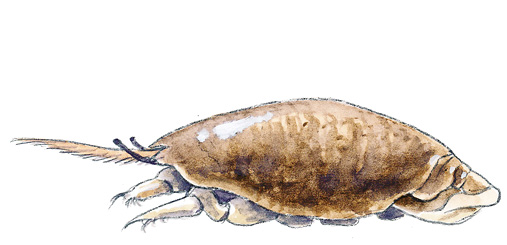
MOLE CRABS OR SAND CRABS

Pacific Mole Crab, Emerita analoga
Order: Decapoda (Mole Crabs or Sand Crabs)
Size: Up to 1 1⁄2" (females larger than males)
Habitat: Intertidal zone on sandy beaches
Range: Coastal western United States
The ubiquitous Pacific Mole Crab (also known as the Pacific Sand Crab) thrives on sandy beaches in the zone where the waves wash in and out. Facing the water, they plant their hindquarters in the sand, and as a wave retreats, they use specialized antennae to filter tiny bits of planktonic material into their mouths. When uncovered by water, they quickly burrow backward into the sand to avoid predation by hungry shorebirds. The sand crab’s body is compact and sturdy, with a tough, sand-colored carapace to protect its thin legs, eyes, and antennae. The tail can be brought up under the body for further protection. Females are typically larger than males, and can be identified by clusters of bright orange eggs on their undersides. Shore anglers are fond of these crabs as bait, as they are a favored prey of many fish.